Great White Shark’s Diet
Always on the lookout for a meal, great white sharks will take a bite out of just about anything in their environment they perceives as a potential meal. The first bite assesses the energy value of the prey, evidenced by a measure — taste — of amount of body fat. The shark will launch an all-out attack on an energy-rich food source, often swallowing it whole after it bleeds to death. Seals are one of the shark’s favorite foods, but they’re not the only item on the great white shark menu.
Marine mammals and fish make up most of the great white shark’s diet. In addition to dining on seal family members including sea lions and elephant seals, the great white preys on dolphins, sea turtles, rays and other sharks.
What Do Sharks Eat?
Sharks are among the most prolific hunters in the seas. As one of the ocean’s apex predators, sharks eat a wide variety of food.
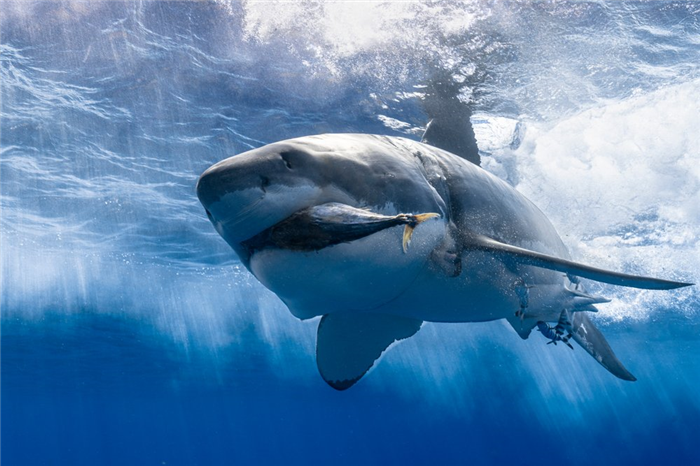
All animal life in the oceans, from the smallest fish to enormous whales, have been prey to a shark. But what do sharks eat in particular?
Do they prefer fish over marine mammals? Let’s go through a shark’s diet and explain where they find the majority of their meals.
The Shark Diet
Sharks come in various shapes and sizes, meaning that their prey will differ depending on the type of shark and where they live.
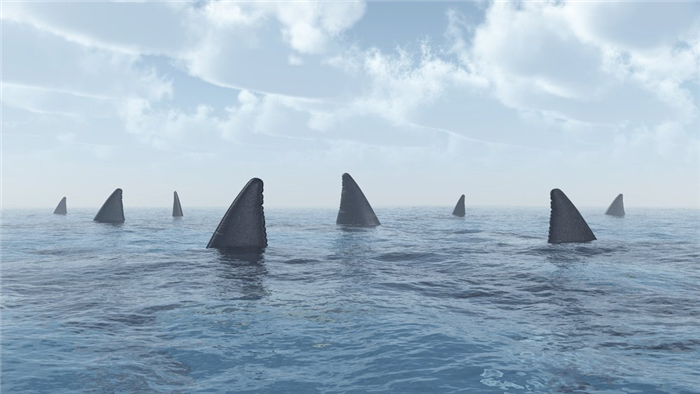
Let’s go through the main sources of sustenance in a shark diet and what different species of sharks generally eat.
Fish of all sizes can end up as prey to a shark—including other sharks! Fish, in general, are the most common prey for sharks.
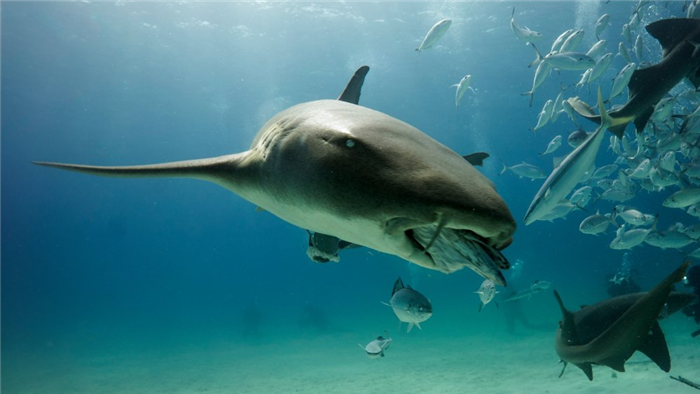
Whether they’re a spiny dogfish all the way to great whites, sharks love eating fish. Some common species of fish sharks hunt include:
Sharks hunt fish by using sensory receptors located on their sides. These sense receptors are called lateral lines, and almost all fish have them.
They help the shark’s nose and eyes find prey by allowing the shark to feel differences in pressure or disturbances in the water.
Fish vary in their nutritional content. Some are high in fats, while others are lean. On average, an ounce of fish meat has between 40 and 80 calories, meaning a shark needs to eat a significant amount to sustain itself.
What Do Great White Sharks Eat?
Great white sharks are perhaps the most famous fish swimming in our oceans. They evoke fear in many, awe in some, and curiosity in others. Great whites can get up to twenty feet long and weigh as much as 5,000 pounds. They are unique among fish in that they keep their blood flowing warmer than the ocean waters around them. Almost no other large fish swims faster than a great white on the hunt. All of this begs the question; just what powers the great white?
Here, we’ll discover what great white sharks eat, how they hunt, and why so many people fear them. We’ll learn why no great whites exist in captivity, and finally, we’ll learn just where baby great whites come from.
What Do Great White Sharks Like to Eat?
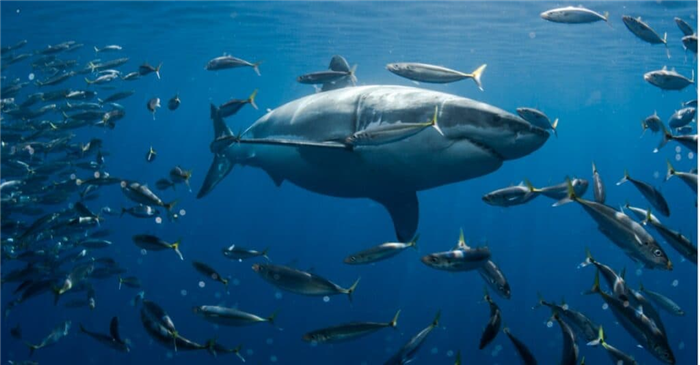
Great white sharks eat seals, sea lions, dolphins, and fish, among other animals. They are carnivores
Great white sharks eat mostly pinnipeds like seals and sea lions. They are carnivores, their diet consists entirely of meat.
9,144 People Couldn’t Ace This Quiz
Think You Can?
Great whites are opportunistic, generalist hunters. This means their diet is far reaching, and they don’t say no to an easy meal. They are epipelagic fish, which means they live in the most shallow layer of the ocean. Great whites tend to congregate wherever large populations of seals abound. Though seals are their favorite food, they will also eat:
- Pinnipeds: Seals, sea lions, northern elephant seals, brown fur seals, harbor seals, California sea lions, and grey seals
- Cetaceans: Dusky dolphins, Risso’s dolphins, bottlenose dolphins, humpback dolphins, harbor porpoises, Dall’s porpoises, beaked whales, and Cuvier’s beaked whales
- Fish: tuna, mackerel, oceanic sunfish
- Seabirds
Great white sharks are apex predators, and need a lot of food to fuel their big bodies. They have even been observed scavenging carrion meat from whale carcasses. They have also been known to attack and kill young or sick humpback whales. Great whites have been found in every major ocean in the world. Though they have no natural predators, humans are their biggest threat.
How Do Great White Sharks Hunt?
Great whites are excellent hunters. They first detect their prey using specialized ampullae of Lorenzini organs. These organs enable the shark to sense the electromagnetic fields emitted by creatures moving around in the water.
Once the great white has sensed a suitable target, they ambush it, swimming towards it at lightning speed, often from below. The shark bites before the prey knows what’s hit it. Most often, the great white lands one catastrophic bite to the target’s body, then it swims off and waits for the prey to bleed out or drown, at which point the shark can eat at its leisure.
Great whites do not chew their food. Instead, if they can’t swallow the whole thing in one bite, they bite the creature, then whip their head back and forth. The great white’s teeth are serrated, and as they jerk their head, the teeth saw off a chunk of flesh. The shark does this, swallowing the chunks whole, until it’s had its fill.
Captive Great White Sharks
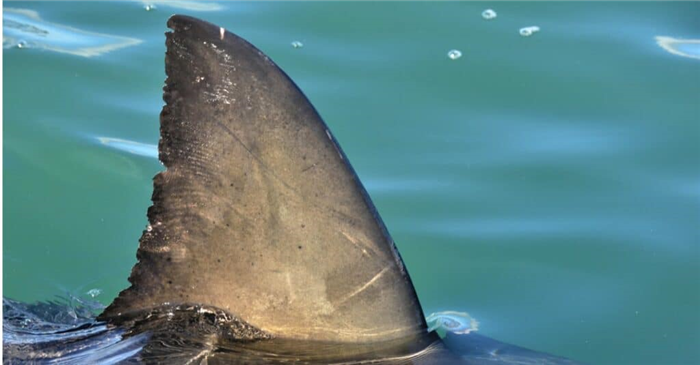
Great white sharks are generalist hunters, which means they eat a wide variety of prey items
There are currently no captive great white sharks anywhere in the world. But, why is this? It should be easy to place a great white in an aquarium, then feed it already dead fish, right?
Wrong. Great white sharks are one of the only fish that cannot survive in aquariums. This is for a couple of reasons. First, great whites swim more than 10,000 miles a year on their migratory routes. Scientists aren’t sure why, but great whites that can’t make these journeys don’t live long. Second, and perhaps most important; great white sharks need a tremendous amount of food every day, and fish just won’t cut it.
Great white sharks need foods that are high in fat and low in bones, like seals and sea lions, to survive. Unfortunately aquariums are not equipped to provide great whites with either the room they need, or the fresh supply of live seals.
Why Do Great White Sharks Attack Humans?
Great white sharks have incredible movement sensing abilities, but their vision is not too great. Scientists think this has something to do with why they sometimes attack humans. Most often, when a great white attacks a person, they back off after the first bite. Scientists theorize that great whites can tell that people are not good eating (too bony) until after they’ve bitten them, but they can’t be certain why these massive sharks so often leave after the first bite.
Little is known about great white sharks, but the fact that they are the apex predators of coastal waters means that they will, occasionally, come into contact with humans. Though, your chances of being attacked by a great white shark are actually less than your chances of being struck by lightning even if they are the most aggressive shark in the world.
What Great White Shark Pups Eat?
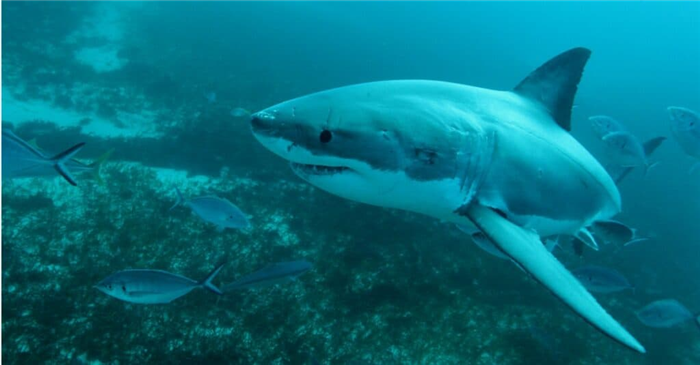
Great white shark pups eat lobster and crab, as well as smaller fish and other sharks
iStock.com/Alessandro De Maddalena
Great whites are ovoviviparous, which means that, while they do have eggs, the females actually incubate the eggs inside their bodies. The eggs even hatch inside the womb. From there the baby sharks, called ‘pups’ gestate for 11 months before the mother births them. Pups have been known to eat unhatched eggs, and even their fellow pups, while still in the womb.
Great white shark pups are over three feet long at birth. They immediately begin hunting, though seals and sea lions won’t be in their diet until they get closer to ten feet long. Great white shark pups eat mostly fish, crabs, lobster, and smaller sharks.
Share this post on:
Brandi Allred
I am a professional writer by day and a fiction writer by night. My nonfiction work focuses on animals, nature, and conservation. I hold degrees in English and Anthropology, and spend my free time writing horror, scifi, and fantasy stories.
Biology [ edit ]
External anatomy [ edit ]
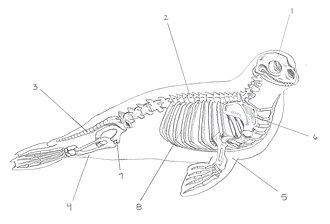
Skeletal anatomy of a harbor seal. 1. Skull. 2. Spine. 3. Tail. 4. Hindlimb. 5. Forelimb. 6. Shoulder. 7. Pelvis. 8. Rib cage.
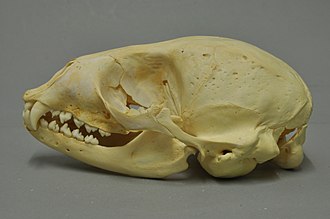
Adult phocids vary from 1.17 m (3.8 ft) in length and 45 kg (99 lb) in weight in the ringed seal to 5.8 m (19 ft) and 4,000 kg (8,800 lb) in the southern elephant seal, which is the largest member of the order Carnivora. Phocids have fewer teeth than land-based members of the Carnivora, although they retain powerful canines. Some species lack molars altogether. The dental formula is: 2–3.1.4.0–2 1–2.1.4.0–2
While otariids are known for speed and maneuverability, phocids are known for efficient, economical movement. This allows most phocids to forage far from land to exploit prey resources, while otariids are tied to rich upwelling zones close to breeding sites. Phocids swim by sideways movements of their bodies, using their hind flippers to fullest effect. [15] Their fore flippers are used primarily for steering, while their hind flippers are bound to the pelvis in such a way that they cannot bring them under their bodies to walk on them. They are more streamlined than fur seals and sea lions, so they can swim more effectively over long distances. However, because they cannot turn their hind flippers downward, they are very clumsy on land, having to wriggle with their front flippers and abdominal muscles.
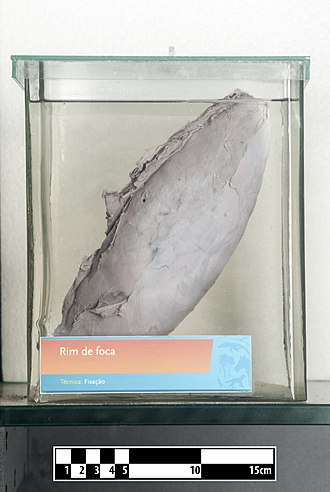
Phocid respiratory and circulatory systems are adapted to allow diving to considerable depths, and they can spend a long time underwater between breaths. Air is forced from the lungs during a dive and into the upper respiratory passages, where gases cannot easily be absorbed into the bloodstream. This helps protect the seal from the bends. The middle ear is also lined with blood sinuses that inflate during diving, helping to maintain a constant pressure. [15]
Phocids are more specialized for aquatic life than otariids. They lack external ears and have sleek, streamlined bodies. Retractable nipples, internal testicles, [16] and an internal penile sheath provide further streamlining. A smooth layer of blubber lies underneath the skin. Phocids are able to divert blood flow to this layer to help control their temperatures. [17]
Communication [ edit ]
Unlike otariids, true seals do not communicate by ‘barking’. Instead, they communicate by slapping the water and grunting.
Reproduction [ edit ]
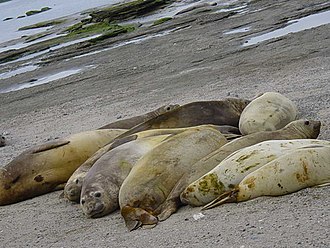
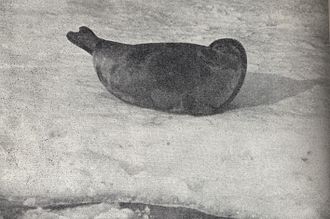
Living only in Lake Saimaa, Finland, Saimaa ringed seals, a subspecies of ringed seal, are among the most endangered seals in the world, having a total population of only about 400 individuals. [18]
Phocids spend most of their time at sea, although they return to land or pack ice to breed and give birth. Pregnant females spend long periods foraging at sea, building up fat reserves, and then return to the breeding site to use their stored energy to nurse pups. However, the common seal displays a reproductive strategy similar to that used by otariids, in which the mother makes short foraging trips between nursing bouts.
Because a phocid mother’s feeding grounds are often hundreds of kilometers from the breeding site, she must fast while lactating. This combination of fasting with lactation requires the mother to provide large amounts of energy to her pup at a time when she is not eating (and often, not drinking). Mothers must supply their own metabolic needs while nursing. This is a miniature version of the humpback whales’ strategy, which involves fasting during their months-long migration from arctic feeding areas to tropical breeding/nursing areas and back.
Phocids produce thick, fat-rich milk that allows them to provide their pups with large amounts of energy in a short period. This allows the mother to return to the sea in time to replenish her reserves. Lactation ranges from five to seven weeks in the monk seal to just three to five days in the hooded seal. The mother ends nursing by leaving her pup at the breeding site to search for food (pups continue to nurse if given the opportunity). “Milk stealers” that suckle from unrelated, sleeping females are not uncommon; this often results in the death of the mother’s pup, since a female can only feed one pup.
Growth and maturation [ edit ]
The pup’s diet is so high in calories, it builds up a fat store. Before the pup is ready to forage, the mother abandons it, and the pup consumes its own fat for weeks or even months while it matures. Seals, like all marine mammals, need time to develop the oxygen stores, swimming muscles, and neural pathways necessary for effective diving and foraging. Seal pups typically eat no food and drink no water during the period, although some polar species eat snow. The postweaning fast ranges from two weeks in the hooded seal to 9–12 weeks in the northern elephant seal. [19] The physiological and behavioral adaptations that allow phocid pups to endure these remarkable fasts, which are among the longest for any mammal, remain an area of active study and research.
Feeding strategy [ edit ]
Phocids make use of at least four different feeding strategies: suction feeding, grip, and tear feeding, filter feeding, and pierce feeding. Each of these feeding strategies is aided by a specialized skull, mandible, and tooth morphology. However, despite morphological specialization, most phocids are opportunistic and employ multiple strategies to capture and eat prey. For example, the leopard seal, Hydrurga leptonyx, uses grip and tear feeding to prey on penguins, suction feeding to consume small fish, and filter feeding to catch krill. [20]
